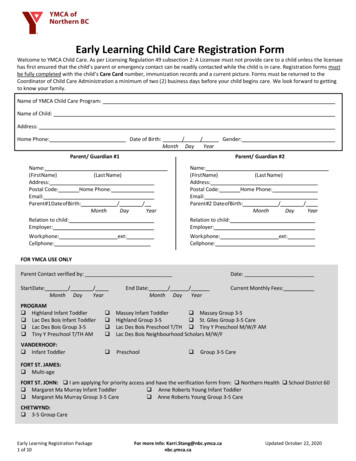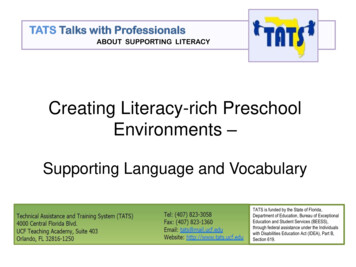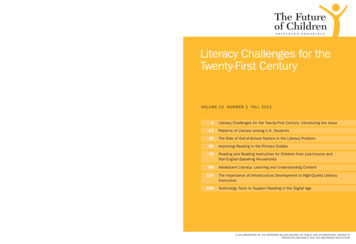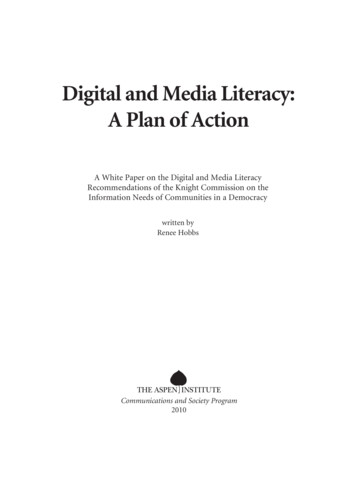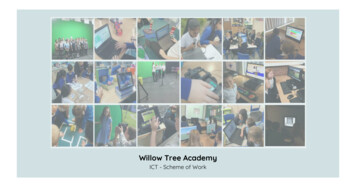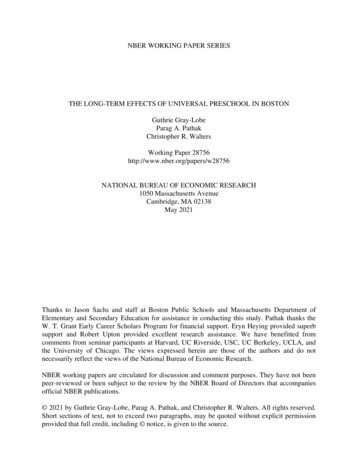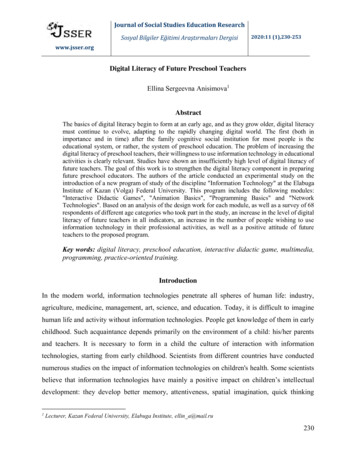
Transcription
Journal of Social Studies Education ResearchSosyal Bilgiler Eğitimi Araştırmaları Dergisi2020:11 (1),230-253www.jsser.orgDigital Literacy of Future Preschool TeachersEllina Sergeevna Anisimova1AbstractThe basics of digital literacy begin to form at an early age, and as they grow older, digital literacymust continue to evolve, adapting to the rapidly changing digital world. The first (both inimportance and in time) after the family cognitive social institution for most people is theeducational system, or rather, the system of preschool education. The problem of increasing thedigital literacy of preschool teachers, their willingness to use information technology in educationalactivities is clearly relevant. Studies have shown an insufficiently high level of digital literacy offuture teachers. The goal of this work is to strengthen the digital literacy component in preparingfuture preschool educators. The authors of the article conducted an experimental study on theintroduction of a new program of study of the discipline "Information Technology" at the ElabugaInstitute of Kazan (Volga) Federal University. This program includes the following modules:"Interactive Didactic Games", "Animation Basics", "Programming Basics" and "NetworkTechnologies". Based on an analysis of the design work for each module, as well as a survey of 68respondents of different age categories who took part in the study, an increase in the level of digitalliteracy of future teachers in all indicators, an increase in the number of people wishing to useinformation technology in their professional activities, as well as a positive attitude of futureteachers to the proposed program.Key words: digital literacy, preschool education, interactive didactic game, multimedia,programming, practice-oriented training.IntroductionIn the modern world, information technologies penetrate all spheres of human life: industry,agriculture, medicine, management, art, science, and education. Today, it is difficult to imaginehuman life and activity without information technologies. People get knowledge of them in earlychildhood. Such acquaintance depends primarily on the environment of a child: his/her parentsand teachers. It is necessary to form in a child the culture of interaction with informationtechnologies, starting from early childhood. Scientists from different countries have conductednumerous studies on the impact of information technologies on children's health. Some scientistsbelieve that information technologies have mainly a positive impact on children’s intellectualdevelopment: they develop better memory, attentiveness, spatial imagination, quick thinking1Lecturer, Kazan Federal University, Elabuga Institute, ellin a@mail.ru230
Journal of Social Studies Education Research2020: 11 (1), 230-253(Abramov & Zima, 1989; Bolstad, 2004; Siraj-Blatchford, 2003). Other researchers suppose thatinformation technologies can harm children's health: they can cause deterioration of vision,posture, emotional state, and nervous system disorder (Gurjev; Hamilton, 2006; Hancox, Milne &Poulton, 2005; Waddell, Hua, Garland, Peters & McEwan, 2007; Titova et al., 2019). Certainly, itis impossible to completely ban the interaction of children with information technologies, becauseif used correctly, they can have a positive impact on their development, but the possible harm tochildren’s health cannot be denied, which makes it necessary to achieve the balance in their use ineducation. Let us try to generate a formula for the application of information technologies in theupbringing of children in this way: the maximum level of the positive influence of informationtechnologies when their negative impact ends to zero. With the reasonable, thoughtful use ofinformation technologies in the educational process, they can serve as an effective tool for trainingsupport and development of preschoolers. At the same time, preschool teachers should realize whatkind of learning impact they would like to achieve with the use of information technologies andapply pedagogical strategies that are adequate to the goals to be achieved (Sousa et al., 2019). Thisdemonstrates that teachers’ digital literacy is an indispensable condition for the effective andadequate integration of information technologies in preschool education. This concept involvesthe knowledge, skills, and understanding necessary for the proper, safe and effective use of digitaltechnologies for the purposes of teaching and learning in teachers’ professional activities and ineveryday private life (Kalash, 2011).The problem of quality training of future teachers has been highlighted in numerous works bymodern researchers (Ahtarieva et al., 2018; Anisimova & Ibatullin, 2018; Kontovourki et. al.,2017; Marsh et al., 2017; Mayoral et al., 2016; Riberio, 2019; Sánchez-Garcia, Mena Marcos,GuanLin & Escribano, 2013; Svensson & Baelo, 2015).The purpose of the study is to strengthen the digital literacy component in the training of futurepreschool educators (Alajmi, 2019). A preschool teacher with digital literacy skills will be able tocompetently select the informational support of educational activities (taking into accountergonomics, children’s age peculiarities, cognitive nature), and, if necessary, take part in the designand development of information products in the educational process, thereby promoting theeffective integration of information technologies in the educational process aimed at the intensivedevelopment of the younger generation (Gabidullina et al., 2019).
Anisimova“Digital literacy is the ability to access, manage, understand, integrate, communicate, evaluate andcreate information safely and appropriately through digital technologies for employment, decentjobs and entrepreneurship. It includes competences that are variously referred to as computerliteracy, ICT literacy, information literacy and media literacy” (“A Global Framework ofReference on Digital Literacy Skills for Indicator”, 2018).However, only the definition of digital literacy is not enough to measure this phenomenon - ameaningful operationalization of the concept, the construction of scales for assessment andobjective measurement are required. One of the first attempts at such operationalization was theproject DigEuLit (Martin & Grudziecki, 2006), implemented in Europe in 2005-2006. Digitalliteracy was then determined through four indicators: computer, information, visual and medialiteracy.Later, in 2011, a UNESCO expert approach was published describing digital literacy through a setof skills needed to work with digital media and to process and search for information (Wilson,Grizzle, Tuazon, Akyempong & Cheung, 2011).The Russian research community also has a serious backlog in the study of digital literacy. Thefirst works describing similar knowledge and skills defined them as “information literacy,” that is,a person’s understanding of the basic ideas of computer science, an understanding of the role ofinformation technology in society, the ability to work with information flows (Ershov, 1988;Mikhailovsky, 1994; Sokolova, 2002).Later, technocratic studies were published, where much attention was paid to infrastructural,technical indicators and the socio-cultural aspects of digital literacy were hardly measured (criticalperception of information, creative thinking, etc.). Moreover, the data collection technique, as arule, was aimed at an Internet audience and excluded a significant number of citizens for whomthe network is not available (Prodanova et al., 2019 a,b; Gerasimov et al., 2019).In this study, the approach proposed by a group of specialists at the G20 Summit in Berlin in April2017 is used to assess the digital literacy of educators (Chetty, Wenwei, Josie & Shenglin, 2017).The approach is based on the assessment of indicators of information, computer, communicativeliteracy, media literacy and attitude to technology. The main advantage of this approach, whichbecame decisive for its choice in the course of a detailed study of international experience in thisfield, is that the indicators of measuring digital literacy are formulated based on an analysis of theobjective needs of the economy - based on big data and machine learning technologies, vacancies
Journal of Social Studies Education Research2020: 11 (1), 230-253are studied and typologized employers' requirements for digital skills and knowledge of candidates(demand-side analysis). At the time of the study, this methodology seems to be the most developedand practice-oriented, it was the result of the joint work of specialists from around the world.Consider the key indicators of digital literacy.1) Information literacy allows people in all walks of life to effectively seek, evaluate, use andcreate information to achieve their personal, social, professional and educational goals(“Overview of Information Literacy Resources Worldwide”, 2013; Sokolova, 2012).An information literate person understands the role and degree of influence of information onlife, knows how to search and find information on various resources, and also understands thebenefits and harms of information.2) Computer literacy. With the development of digital technologies, the groups of people whohave access to them gain more and more opportunities. At the same time, the opportunities ofsocial groups that have less access to digital technologies or do not have it at all decrease, theircompetitiveness decreases (Aymaletdinov, 2012; Franco and Bedin, 2019). A computerliterate person understands the technical components of a computer and the principles of theirinteraction, easily uses digital devices regardless of platform / interface, and also understandsthe "purpose" of the computer and the purpose of its use.3) Communicative literacy is the key to the development and maintenance of social connectionsand social capital of each person (Sokolova, Aymaletdinov, Ivanchenko, Plakhtiy & Voronina,2009; Kireev et al., 2019). A communicatively competent person understands the differencesbetween digital communications and live communication, knows how to use modern meansof communication - social networks, instant messengers, and also realizes the existence of aspecial ethics and communication standards in a digital environment.4) Media literacy allows a person to navigate the media space, search for news, assuming thatthe media can cover them incompletely or unreliably. The skill of working with the media,like the other skills that shape digital literacy, leads to an improvement in the quality of life(Gambarato, 2017). A media-literate person understands the variety of sources of information,forms and channels of its distribution, knows how to search for news in different sources,check their completeness and accuracy, and is also critical of information messages and news.5) A person’s attitude to innovative technologies is on a par with informational, computer,communicative and media literacy. If a person follows technology, he is more interested in
Anisimovadeveloping his own digital literacy. A person who takes technology positively is characterizedby the fact that he understands technological trends, is ready to work with new and moderntechnologies - applications, gadgets, and also understands the benefits of technologicalinnovations both for the development of society and himself.The demand for digital literacy in all areas of professional activity today is quite obvious, itbecomes simply impossible not to notice it, since progress requires the development of acompletely different level of competencies from a modern person (Korableva et al., 2019). In thisregard, a promising measure is seen in strengthening the component relating to digital literacy ofstudents of all areas of training, primarily pedagogical, since the literacy of the students themselveswill depend on how competent the teacher is. All these indicators of digital literacy are undeniablyimportant; therefore, it is necessary to work to improve them.Some researchers have been analyzing challenges to educators' digital literacy. The authors of thepaper (Marsh, Kontovourki, Tafa & Saloma, 2017) identify some of the digital literacy barriers forteachers when working with preschool children, including teachers’ traditional beliefs andattitudes, lack of their knowledge, skills and abilities, lack of self-confidence, lack of equipment,software, lack of funding, etc.Researchers also propose the formation of individual indicators of digital literacy.The work (Sánchez-Garcia et al., 2013) proposes the organization of advanced training of workingteachers on the following modules: information and operating systems, interactive tools andmultimedia materials. The results of the experiments showed the high efficiency of the training, aswell as high satisfaction of course participants. Moreover, course participants found the modulededicated to working with multimedia materials more useful than the first module. So, this studyis aimed at improving information, computer literacy, as well as the attitude to technology.The work (Sazonova & Alekseenko, 2017) suggested the formation of ICT competence of alreadyworking preschool teachers based on improving their skills as well. According to this approach,already working teachers receive basic skills in working with information technologies. This workis aimed at improving information and computer literacy.The paper (Mayoral et al., 2016) proposes a program to study the discipline "Information andCommunication Technologies" for master’s students – future teachers of secondary schools. Theauthors identify three blocks in the program: "Communication, Interaction and CollaborativeResources", "Educational Resources" and "Multimedia Educational Resources Generation". The
Journal of Social Studies Education Research2020: 11 (1), 230-253experiment results also showed high training efficiency and students’ high satisfaction withteaching. This study aims to increase all indicators of digital literacy. However, the programproposed here is intended to train high school teachers.It should be noted that existing studies on improving digital literacy are mainly devoted tosecondary school teachers. For teachers of preschool education, there are practically no worksdevoted to improving their digital literacy. Therefore, in this study, a program is proposed toincrease the digital literacy of future preschool educators. It is based on active work on allindicators (information, computer, communicative literacy, media literacy and attitude totechnology) of digital literacy.MethodResearch DesignThe study was conducted at the Elabuga Institute of Kazan (Volga Region) Federal University.When conducting the study, the following methods were used: source analysis, questionnaires,experiment, project method, methods of mathematical statistics.ParticipantsThis study involved students in the direction of “Pedagogical education” and the profile of training“Preschool education. Primary education”, belonging to different age categories (68 students intotal, age - 21-39 years old). To analyze digital literacy of students belonging to different agecategories, students were divided into 4 groups: 21-25 years old, 26-29 years old, 30-34 years old,35-39 years old (Figure 1). In each group there was an almost equal number of students. The resultsof the questionnaires, estimates of design work are also given in accordance with age categories.Figure 1. Age of participants
AnisimovaInstrumentationsFor questionnaires, questionnaires were used. Surveys were conducted anonymously.The preliminary questionnaire included 4 questions that determined the desire to use informationtechnology in professional activities and the desire to increase the level of digital literacy. Thequestionnaire to determine the initial and final level of digital literacy included 15 questionspresented in the form of polar pairs of statements describing knowledge, skills and attitudesregarding the five main dimensions of the digital environment: information, computer technology,media, communications and innovation. All 15 indicators corresponding to the questionnaire areassigned the same weighting factors, since at this stage there is no reason to argue that ght)thanothers.The final questionnaire included 7 questions that determined the usefulness of the programcomponents of the program and the desire to apply information technology in professionalactivities.To conduct an experiment on studying the discipline "Information Technologies", a multimediaaudience was used, equipped with a multimedia projector, an automated projection screen, anacoustic system, as well as an interactive tribune for the teacher, a conference microphone, awireless microphone, a multi-station with a light tablet for a multi-studio, a digital camera, a videocamera. The student's workplace includes a computer desk, chair, personal computer, licensedsoftware (Adobe Photoshop, CorelDraw, Microsoft Office, First, Windows Movie Maker, I CanAnimate, iStopMotion, Smart Notebook). Each computer has broadband Internet access. Allcomputers are connected to the corporate computer network of KFU and are in a single domain.Data Collection1. Before starting the study, all students took part in an anonymous questionnaire survey, whichcontained the following questions:1) Your age:a) 21-25 years old;b) 26-30 years old;c) 31-35 years old;d) 36-40 years old.2) In your opinion, should information technologies be applied in preschool education?a) Yes;
Journal of Social Studies Education Research2020: 11 (1), 230-253b) No;c) I don’t know.3) Do you want to improve your information literacy?a) Yes;b) No.4) Will you use information technologies in your educational activities?a) Yes;b) No;c) Not sure.2. A questionnaire was conducted to determine the initial level of digital literacy of students(Aymaletdinov et al., 2019).3. Next, an experiment was conducted to introduce a new discipline program "InformationTechnology".The proposed program includes the following modules:1) Interactive Didactic Games;2) Animation Basics;3) Programming Basics;4) Network Technologies.Let us take a closer look at each module.1) A game is the main form of activity in preschool age. Therefore, classes in preschool institutionsare most effective if they are in the form of a game. A future teacher should be able not only to useready-made game versions at lessons but also to independently design and develop simple games.In this regard, the first module provides for the training of students – future teachers in the designand development of interactive didactic games. As part of this module, students also acquire basicskills of working with device tools for developing and editing multimedia applications (AdobePhotoshop, CorelDraw, etc.) and an interactive board, the ability to analyze information productsin terms of ergonomics and their influence on the harmonious personality development of theyounger generation. Within this module, students develop a set of didactic games in MicrosoftPowerPoint and Smart Notebook (Borisenko, 2015; Popova et al., 2019; Borisenko & Volodina,2015; Dong & Jong, 2013). In Microsoft PowerPoint, students learn to work with triggers,animation, and control elements. In Smart Notebook, they learn screen shading technologies
Anisimova("curtains"), multiple cloning utilities, the Eraser tool, object sequencing technologies. Afterstudying these programs, each student defends the work done (Nagimzhanova et al., 2019). Duringthe defense, the whole group evaluates the work of each student according to several criteria: Game ergonomics (0-5 points); Originality (0-5 points); The quality of artistic performance. The artistic level of the work, design elements,the harmonious color combination, the quality of the compositional solution areassessed (0-5 points); The quality and complexity of the technical performance of the work. The validityand reasonableness of the choice of the instruments and tools used are assessed (0-5points); Cognitive nature of a game (0-5 points); Fascination of a game (0-5 points); Compliance with children’s age peculiarities (0-5 points).The final estimate of the project is the average value of the estimates for all criteria.Note that the tools for developing and editing multimedia applications within this module arestudied as auxiliary tools in the development of game applications. Nevertheless, the importanceof learning the basics of working with them for teachers’ future professional activity is obvious,although in many reports the work with these tools is not considered.This module contributes to the formation of information, computer literacy, as well as the attitudeto technology.2) Within the second module, students learn the basics of animation. This module implies theteamwork of students. Each team creates a cartoon based on folk tales. In a team, studentsdistribute the roles on preparing characters and cartoon scenery, creating photographs, dubbing,music overlapping and editing. Cartoon characters and scenery can be made from plasticine, paper,glass beads, etc. Windows Movie Maker, I Can Animate, and iStopMotion can be used for filmediting. As part of this module, students also learn to work with digital equipment. After thecreation of cartoons, each team defends its work. Students assess the cartoons made by thefollowing criteria: originality of content and performance (0-5 points); the use of artistic-expressive means (the power of emotional impact) (0-5 points);
Journal of Social Studies Education Research2020: 11 (1), 230-253 disclosure of a given topic, script (0-5 points); level of special effects (0-5 points); technical mastery (revision, editing, sounding and processing of the material) (0-5points).The final estimate of the project is the average value of the estimates for all criteria.This module is interesting; after having learned it, a teacher can teach children to create cartoons,work with a digital camera and video camera, as well as with video editors.This module is also aimed at the formation of information, computer literacy, as well as the attitudeto technology.3) Teachers should also work on the formation of children's logical thinking. Therefore, in thethird module, students acquire programming skills in the PervoLogo program. The possibilities ofthis program as a simple graphic editor, text editor, music editor, as well as a programminglanguage, are being explored. This program allows creating simple algorithms with a performerTurtle. Students learn basic commands: "Go", "Turn", "Change a Pen", "Increase", "Decrease","Stamp", "Turn Everything off", "Freeze" and the principles of working with the performer. At theend of this module, students also defend the work. The creation of cartoons by each student isenvisaged as the final work. Students’ final works are evaluated according to the following criteria: Originality of the work (0-5 points); The quality and complexity of the technical performance of the work (0-5 points); Script. Completeness, consistency, detailed elaboration and originality of the scriptare evaluated (0-5 points); The quality of artistic performance (0-5 points).The final estimate of the project is the average value of the estimates for all criteria.Thus, when studying the discipline "Information Technologies", students master a technology ofdeveloping interactive didactic games, creating cartoons, and study working with graphic andvideo editors, digital equipment.This module is also aimed at the formation of information, computer literacy, as well as the attitudeto technology.4) It is useful for a modern teacher to work on the Internet. Therefore, in the fourth module,students become familiar with Internet services: a mapping system Google Maps, an automatictranslation service Google Translate, photo editing and publishing service Google Photos, full-text
Anisimovasearch service Google Books, a text, spreadsheet and presentation editor Google Docs, a bloggingplatform Blogger, a geo-information system Google Earth, etc. The final work is the developmentof a site-portfolio using Google Sites or the platform Wix.com. Site evaluation criteria are asfollows: Consistency in the same style of fonts, graphics, colors (0-5 points); Balance of information on the site pages (0-5 points); Graphic quality (0-5 points); Text readability (0-5 points); Color design (0-5 points); Content quality (0-5 points); Feedback (0-1 points); Convenience of the navigation mechanism (0-5 points); Correct work of references (0-5 points); Lack of dead-end pages (0-1 points); Lack of grammatical and syntactic errors (0-5 points).The final estimate of the project is the average value of the estimates for all criteria.This module is aimed at the formation of information, communication, media literacy.4. After studying the proposed program, a questionnaire was again conducted to determine thefinal level of digital literacy of students (Aymaletdinov, Baimuratova, Zaitseva, Imaev &Spiridonova, 2019).5. At the end of the study, an anonymous questionnaire survey of students was conducted; it wasaimed at determining the usefulness of the modules studied. The questionnaire included thefollowing questions:1) Your age:a) 21-25 years old;b) 26-30 years old;c) 31-35 years old;d) 36-40 years old.2) Assess the usefulness of the module "Interactive Didactic Games" (0-5 points):points.
Journal of Social Studies Education Research2020: 11 (1), 230-2533) Assess the usefulness of the module "Programming Basics" (0-5 points): points.4) Assess the usefulness of the module "Animation Basics" (0-5 points): points.5) Assess the usefulness of the module "Network Technologies" (0-5 points):points.6) Will you use information technologies in your educational activities:a) Yes;b) No;c) Not sure.7) Your feedback on the course completed:.Data analysis techniquesMethods of mathematical statistics were used for the data analysis.Findings1) A preliminary questionnaire was aimed at identifying the level of digital literacy and the desireto use information technology in professional activities. The results of the preliminaryquestionnaire are shown in Figure 2. Figures (a), (b), (c) illustrate the answers to questions 2-4.Answers to questions are grouped by age category. For each age category, the column is dividedinto parts of different colors in proportion to the number of answers of students of this age category.(a)(b)(c)Figure 2. Results of the initial survey – answers to the questions: (a) – Is it necessary to applyinformation technologies in preschool education? (b) – Do you want to improve informationliteracy? (c) – Will you use information technologies in your educational activities?Consider the results of the survey for each age group separately. 95% of the students aged 21 to25 think that information technologies are necessary in preschool education. All 100% of students
Anisimovawant to improve information literacy. 83% of them are going to use information technologies ineducational activities.67% of the students aged 26 to 30 thinks that information technologies are necessary in preschooleducation. 94% of students want to improve information literacy. 79% of them are going to useinformation technologies in educational activities.44% of the students aged 31 to 35 thinks that information technologies are necessary in preschooleducation. 94% of students want to improve information literacy. 76% of them are going to useinformation technologies in educational activities.93% of the students aged 36 to 40 want to increase the level of information literacy. 67% of themare going to use information technologies in educational activities.2) Next, a questionnaire was conducted to determine the initial level of digital literacy of studentsof different age categories. The survey results are presented in table 1.Table 1The results of the survey to determine the initial level of digital literacy of students of different agecategoriesPrivate Index mmunicativeliteracyMedia literacyAttitude toLiteracy Indextechnology21-25 years old79%84%86%80%95%85%26-30 years old76%77%80%75%90%80%31-35 years old70%72%80%72%80%75%36-40 years old68%70%75%70%75%72%Whole group73%76%80%74%85%78%Columns 2-4 show the average values of private digital literacy indices (indicators), and column 5shows the digital literacy index, calculated as the average of private indices for each age groupseparately. The last line shows the average values of private indices and the final index of digitalliteracy for the entire group as a whole.
Journal of Social Studies Education Research2020: 11 (1), 230-253The average digital literacy index of the entire group is 78% - this is not a high enough level,so work is needed to increase it. The highest index of digital literacy (85%) is observed amongstudents of the youngest age group, the smallest (72%) is among the oldest, so we see a agegroups.3) In the framework of the discipline "Information Technology" mastered the following modules:1) Interactive Didactic Games;2) Animation Basics;3) Programming Basics;4) Network Technologies.The development of each module was a project. The project rating is in the range of 0-5points. To evaluate the projects, a commission was organized from among the teachers specializingin information technology. The results of the development of the modules were grouped by agecategory. The results include an average score for each age category for each module and standarddeviation.Table 2The results of the study of modules by age categoriesInteractive DidacticGamesAnimation BasicsProgramming BasicsNetwork iationestimatedeviati
The basics of digital literacy begin to form at an early age, and as they grow older, digital literacy . information, visual and media literacy. Later, in 2011, a UNESCO expert approach was published describing digital literacy through a set . The work (Sánchez-Garcia et al., 2013) proposes the organization of advanced training of working .
